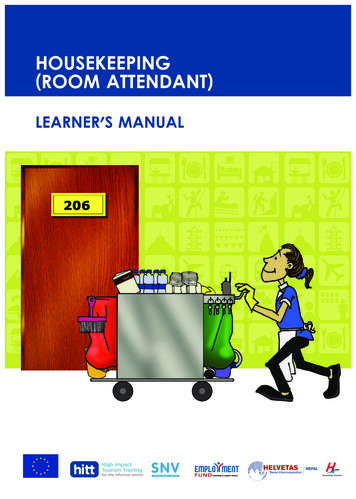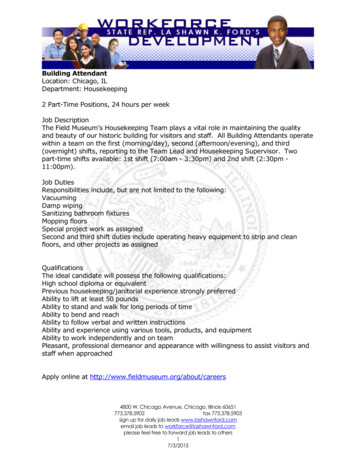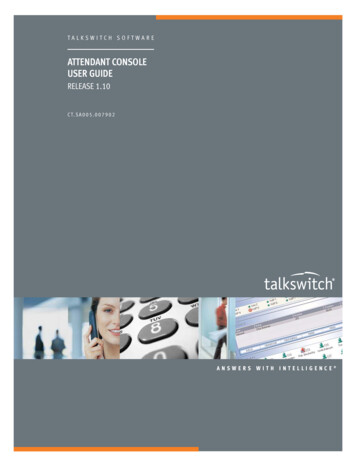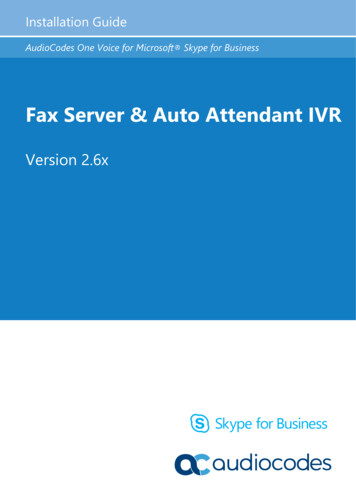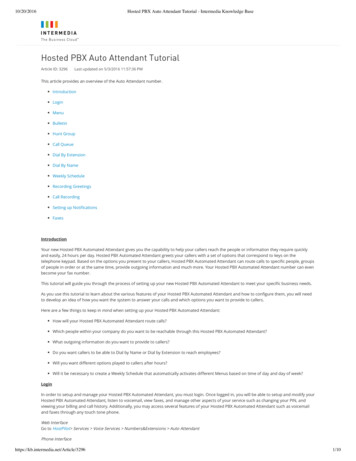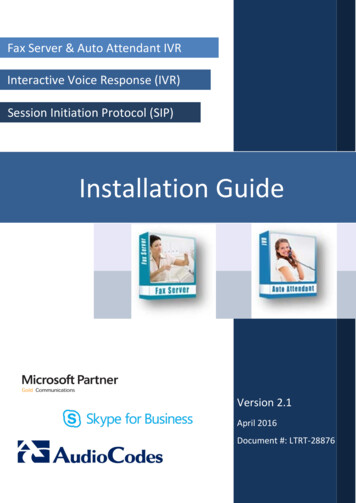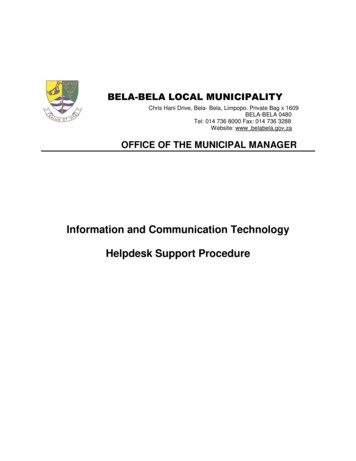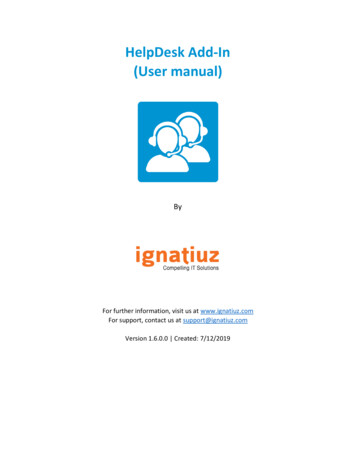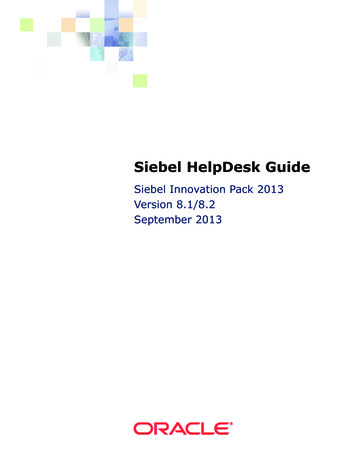
Transcription
IT-ITESDOMESTIC IT HELPDESK ATTENDANTREFERENCE ID: SSC/Q0110
WELCOME NOTEInformation Technology (IT) and Information Technology-enabled Services (ITeS) are one of the mostsignificant growth stimulator of the Indian economy. IT industry has not only influenced theemployment prospects of the people but also affected the social lives of the people by connectingthem through network and social websites. The major segments of the Industry are IT Services,Business Process Outsourcing (BPO), engineering services, research and development and products. omputers,servers,workstations,supercomputers, data processing equipment, printers, digitizers, etc. Much of the IT related activitiesare centred on services in Banking, Financial Services, Insurance, Telecommunication, Manufacturing,and Retail.Indian IT Industry has been contributing substantially to India's Gross Domestic Product, exports andemployment. The sector is responsible for enabling employment to an additional 8.9 million people invarious associated sectors, such as security, transportation, housekeeping, catering, etc. It has growntremendously over the last 15 years. The industry employs around 2.2 million people.IT Helpdesk Attendant in IT-ITeS Industry is also known as Helpdesk Executive, Service Desk Executive,Technology Support Executive, IT Support Executive, and Helpdesk Coordinator. An IT helpdeskattendant is the initial point of contact for internal company customers seeking assistance and supportwith the company’s intranet, desktop devices, and other business applications that are maintained bythe support team. Primary responsibility of individuals at this job is to provide user support, managingCustomer Service Desk application, responding to all incoming service requests and customer service;quickly diagnose technical issues and arrange solutions during normal operational business hours.He/she should be responsible for the smooth running of computer systems and ensuring users getmaximum benefits from them.The tasks of a Helpdesk Attendant vary depending on the size and structure of the organization andmay include installing and configuring computer hardware operating systems and applications;monitoring and maintaining computer systems and networks; dealing with staff/clients either face toface or over the telephone to help set up systems or resolve issues; troubleshooting network problemsand diagnosing and solving hardware/software faults of IT Helpdesk Attendant.The job of IT Helpdesk Attendant requires the individual to have thorough knowledge of varioustechnology trends and processes as well as have updated knowledge about IT initiatives. He/she shouldbe highly motivated and energetic to timely respond to all issues, updates internal customers on status,solicits additional information, and troubleshoots issues. IT Helpdesk Attendant can explore jobopportunities in IT multi-national companies, private IT organizations, IT call centers, IT software orequipment suppliers, IT maintenance companies, etc.This Student Handbook will help you learn and practice the skills required to become a Domestic ITHelpdesk Attendant. You can highlight the important points and make notes too. The more you interactwith the handbook, the more you learn.Domestic IT Helpdesk Attendant2
It contains Activities to be performed in class and at home as well as Study Material for you to read.This handbook will help you to learn better during the course and be useful later as a reference.You will find this course material useful both for studying and as future reference. We welcome yourfeedback on any issue relating to this course and wish you all the best. Happy Learning!Objectives of the CourseUpon completion of this course, you will be able to: Demonstrate the knowledge of modern computers and their parts and peripherals Communicate effectively at workplace Describe the use of various operating systems and software Demonstrate the knowledge of health, safety and security issues and follow best practices Demonstrate the knowledge of helpdesk system fundamentals Demonstrate the knowledge of fundamentals of network operating systemsDomestic IT Helpdesk Attendant3
Table of ContentsUnit - 1Introduction to IT-ITES IndustryPage No.(6-9) Unit - 2Introduction to IT-ITES IndustryObjectives of the CourseMeaning of IT HelpdeskRoles & Responsibilities of IT Helpdesk AttendantRequired Skills to become an IT Helpdesk AttendantComputer FundamentalsPage No.(10-18) Unit - 3Basic PC Troubleshooting (Hardware/Software) Unit - 4History of ComputersAdvantages & Disadvantages of ComputersHardware & SoftwareClassification of SoftwareSystem Software & Application SoftwareUtility ProgramsLibrary ProgramsBooting of DOS/WindowsTypes of Computer CardsProcessor & MotherboardInstallation of SMPSDismantling & Assembling ComputerInstalling & Connecting Various Types of Hard Disk DriveConfiguring, Partitioning & Formatting of Hard Disk DriveInstalling MotherboardDOS & Windows Installation/ConfigurationAntivirus DownloadPrinters Driver InstallationUninstalling the DriversHard Disk Booting IssueNetwork Connectivity IssueSetting up a Wi-Fi NetworkCommon Browser Issues & TroubleshootingSafe Mode & its UseRemote DesktopWindows & MS-Office ShortcutsDealing with IT Service Requests/IncidentsPage No.(19-223)Page No.(224-231) Monitor & Verify Automated Alerts for customer servicerequestsObtain Sufficient Information from CustomerCapture Queries/Complaints of Customers in CRM, RegisterDomestic IT Helpdesk Attendant4
Unit - 5Planning and Organising Work to Meet Expected Outcomes Unit - 6or MS ExcelPrioritize Service Requests According to OrganizationalGuidelinesResolve First Level Complaints at Front EndAddress Customer’s Query, Request or Complaint on the Basisof CategorizationRefer the Problem to a Competent Technical Support TeamCustomer Query ResolutionWorkaroundFollow Escalation Matrix to Resolve Customer IssuesSeeking Advice and Guidance from Line ManagerUpdate Customer on Time Required for Resolution of a QueryAdhere to Timelines for Resolving Customer IssuesOffer 100% Resolution of Customer’s Complaints withoutDelayMaintaining Cleanliness at WorkSelf-Discipline and PunctualityComplying with Company Policy and RulesChecking Work for AccuracySeeking Advice and Guidance from Line ManagerUnderstanding the Work Output RequirementsMaintain a Healthy, Safe and Secure Working Environment Complying with organization’s current health, safety andsecurity policies and proceduresReporting any identified breaches in health, safety, andsecurity policies and proceduresIdentifying and correcting any hazards that you can deal withsafelyReporting any hazards that you are not allowed to deal withto the relevant personIdentify and recommend opportunities for improving health,safety, and security to the designated personFollowing Emergency ProceduresComplete any health and safety records legibly andaccuratelyDomestic IT Helpdesk AttendantPage No.(232-249)Page No.(250-257)5
Unit 1 – Introduction to IT-ITES IndustryLearning Objectives: Introduction to IT-ITES IndustryObjectives of the CourseMeaning of IT HelpdeskRoles & Responsibilities of IT Helpdesk AttendantRequired Skills to become an IT Helpdesk AttendantIntroduction to IT-ITES ServicesInformation Technology (IT) and Information Technology-enabled Services (ITeS) are one of the mostsignificant growth stimulator of the Indian economy. IT industry has not only influenced theemployment prospects of the people but also affected the social lives of the people by connectingthem through network and social websites.The major segments of the Industry are IT Services, Business Process Outsourcing (BPO), engineeringservices, research and development and products. IT Products being manufactured in India includepersonal computers, servers, workstations, supercomputers, data processing equipment, printers,digitizers, etc. Much of the IT related activities are centered on services in Banking, Financial Services,Insurance, Telecommunication, Manufacturing, and Retail.Indian IT Industry has been contributing substantially to India's Gross Domestic Product, exports andemployment. The sector is responsible for enabling employment to an additional 8.9 million people invarious associated sectors, such as security, transportation, housekeeping, catering, etc. It has growntremendously over the last 15 years. The industry employs around 2.2 million people.Internet has made revolutionary changes with possibilities of online booking of tickets rail or air, filingIncome Tax returns, online application for passports, online banking, etc. With an internet user-base ofover 125 million, which is likely to grow to about half-a-billion over the next few years, and also anestablished base of 950 million mobile users, India will be a key player in the cyber-world.With biometric technology fast maturing and becoming increasingly sophisticated, biometric solutionsare starting to make serious inroads as a high-tech identity management and verification tool withinthe society. Such momentum has introduced the new possible markets for biometric data operatorwhich has the largest impact on future societies. Future scope of the biometric systems in customer‟sidentification and authentication is seen in access and attendance control, travel control, financial andother transactions requiring authorization, remote voting (authorization) and use in automatic workingdevices.Objectives of the CourseUpon completion of this course, you will be able to: Demonstrate the knowledge of modern computers and their parts and peripheralsCommunicate effectively at workplaceDescribe the use of various operating systems and softwareDemonstrate the knowledge of health, safety and security issues and follow best practicesDomestic IT Helpdesk Attendant6
Demonstrate the knowledge of helpdesk system fundamentalsDemonstrate the knowledge of fundamentals of network operating systemsIT HelpdeskIT Helpdesk is a service providing information and support to computer users, especially within acompany.In a business enterprise, a help desk is a place that a user of information technology can call to gethelp with a problem. In many companies, a help desk is simply one person with a phone number and amore or less organized idea of how to handle the problems that come in.In larger companies, a help desk may consist of a group of experts using software to help track thestatus of problems and other special software to help analyze problems (for example, the status of acompany's telecommunications network).Typically, the term IT Helpdesk is used for centralized help to users within an enterprise. A relatedterm is call center, a place that customers call to place orders, track shipments, get help withproducts, and so forth.The World Wide Web offers the possibility of a new, relatively inexpensive, and effectively standarduser interface to help desks (as well as to call centers) and appears to be encouraging more automationin help desk service.Some common names for a helpdesk include: Computer Support Center, IT Response Center, CustomerSupport Center, IT Solutions Center, Resource Center, Information Center, and Technical SupportCenter.IT Helpdesk AttendantIT Helpdesk Attendant in IT-ITeS Industry is also known as Helpdesk Executive, Service Desk Executive,Technology Support Executive, IT Support Executive, and Helpdesk Coordinator.An IT helpdesk attendant is the initial point of contact for internal company customers seekingassistance and support with the company‟s intranet, desktop devices, and other business applicationsthat are maintained by the support team.Primary responsibility of individuals at this job is to provide user support, managing Customer ServiceDesk application, responding to all incoming service requests and customer service; quickly diagnosetechnical issues and arrange solutions during normal operational business hours. He/she should beresponsible for the smooth running of computer systems and ensuring users get maximum benefits fromthem.Roles & Responsibilities of IT Helpdesk AttendantThe tasks of a Helpdesk Attendant vary depending on the size and structure of the organization andmay include: Installing and configuring computer hardware operating systems and applications;Monitoring and maintaining computer systems and networks;Domestic IT Helpdesk Attendant7
Dealing with staff/clients either face to face or over the telephone to help set up systems orresolve issues;Troubleshooting network problems and diagnosing and solving hardware/software faults of ITHelpdesk Attendant.What does it take to work at an IT Help Desk?The job of IT Helpdesk Attendant requires the individual to have thorough knowledge of varioustechnology trends and processes as well as have updated knowledge about IT initiatives. He/she shouldbe highly motivated and energetic to timely respond to all issues, updates internal customers on status,solicits additional information, and troubleshoots issues. IT Helpdesk Attendant can explore jobopportunities in IT multi-national companies, private IT organizations, IT call centers, IT software orequipment suppliers, IT maintenance companies, etc.Here are some of the most commonly sought-after skills for a IT Help Desk AttendantThe Necessary SkillsIf you’re an IT worker, these skills are the basics that IT help desks look for:1. Troubleshooting PC problems in real eneighbours/roommates/family call when they can’t get the printer to work?personyour2. You know when it’s time to do an OS reloadKnowing when to cut your losses is both an art and a science.3. You have good research capabilities on Google and other search enginesWhen your grasp of terminology helps you do great research for figuring out unusual problems, yourvalue to an IT help desk increases.4. You have your A , Microsoft-certified desktop support technician, and Network certificationsHelp desk workers generally have an associate’s or bachelor’s degree, certifications, or diplomas ininformation technology and a handful of basic certifications.5. You understand the importance of good customer service skills.After all, it isn’t just about technology. It’s about helping people do their jobs.Great Bonus Qualifications1. Excellent writing skills.If you write clearly and grammatically and can express technical problems and solutions that theaverage end user can understand, then you will be a big asset to an IT help desk, particularly if it useshelp desk software that builds a knowledge base from resolved tickets.Domestic IT Helpdesk Attendant8
2. Great phone skills.Your phone interview is extremely important, not just for discussing qualifications, but also becauseyour potential employer can gauge your phone skills. If you make it clear that you’re listening, don’tinterrupt, and answer in a friendly and thoughtful manner, you’re gold.3. Good mechanical skills.If you have skills making mechanical and electrical things work, this can be a big plus to an IThelp desk.Skills That Say, “Hire This Person Immediately.”There are few more skills that should prompt a smart IT recruiter to hire you:1. Direct experience with (or certifications from) software and hardware vendorsIf these match up with the vendors the employer uses, you have a huge advantage over applicantswithout this experience.2. Freelance developer experienceIf you have freelance developer experience, not only do you have the technical skills necessary forIT help desk work, you also have the initiative and discipline to get things done without beingmicromanaged.3. Programming language certifications.If you have experience or certifications, you probably have the strong attention to details plus theanalytical skills that any company would like to have in a help desk worker.Great IT help desk workers and great help desk software are two of the best investments a companycan make. A consistently updated knowledge base with resolved service tickets and a self-serviceportal that allows motivated end users to solve their own minor IT problems, help desk workers arefree to tackle the more difficult IT issues that arise, allowing your business to run smoothly andprevent wasted time.Domestic IT Helpdesk Attendant9
Unit 2 - Computer FundamentalsLearning Objectives: History of ComputersAdvantages & Disadvantages of ComputersHardware & SoftwareClassification of SoftwareSystem Software & Application SoftwareUtility ProgramsLibrary ProgramsFundamentals of Computer SystemsHistory of Computer: The computer as we know it today had its beginning with a 19th century Englishmathematics professor name Charles Babbage.He designed the Analytical Engine and it was this design that the basic framework of the computers oftoday are based on. Generally speaking, computers can be classified into three generations. Eachgeneration lasted for a certain period of time, and each gave us either a new and improved computeror an improvement to the existing computer.Generations of Electronic ComputersGenerationFirstSecond Gen.Third Gen.Fourth Gen.Gen. IIIIIIIVTechnologyVacuum tors)Microchips(millions oftransistors)SizeFilled WholeBuildingsFilled half aroomSmallerTiny - Palm Pilotis as powerful asold building sizedcomputerDomestic IT Helpdesk Attendant10
How Electronic Computers Have Progressed?UNIVACKenbak 1(1971)IBM PC(1951-1970)(1981)Macintosh PentiumIII(1984)(1968 *130Intel 8088IntegratedCircuitsMicrochip - 29,000TransistorsMotorola68000Intel P-IIIMicrochip- AMMemory512 K265 Bytes256 K640 K128 MbSpeed1.3 MHz1 KHz4.77 Mhz8 MHz1000 MHzStorage100 MB HardDrivenoneFloppy DriveFloppyDrivesHardDrive,Floppy,CD-RomSizeWhole RoomBriefcaseBriefcase MonitorTwoSmallshoeboxes Tower(integratedmonitor) 1595 4000(nomonitor)Cost 1.6 millionDomestic IT Helpdesk Attendant 750 150011
Advantages of ComputerComputer has made a very vital impact on society. It has changed the way of life. The use of computertechnology has affected every field of life. People are using computers to perform different tasksquickly and easily. The use of computers makes different task easier. It also saves time and effort andreduces the overall cost to complete a particular task.Many organizations are using computers for keeping the records of their customers. Banks are usingcomputers for maintaining accounts and managing financial transactions. The banks are also providingthe facility of online banking. The customers can check their account balance from using the internet.They can also make financial transaction online. The transactions are handled easily and quickly withcomputerized systems.People are using computers for paying their bills, managing their home budgets or simply having somebreak and watching a movie, listening to songs or playing computer games. Online services like Skypeor social media websites are used for communication and information sharing purposes.Computer can be used as a great educational tool. Students can have access to all sort of informationon the internet. Some great websites like Wikipedia, Khan’s Academy, Code Academy, Byte-Notesprovides free resources for students & professionals.Moreover, the computer is being used in every field of life such as medical, business, industry, airlineand weather forecasting.Disadvantages of ComputerThe use of computer has also created some problems in society which are as follows.Unemployment: Different tasks are performed automatically by using computers. It reduces the needof people and increases unemployment in society.Wastage of time and energy: Many people use computers without positive purpose. They play gamesand chat for a long period of time. It causes wastage of time and energy. Young generation is nowspending more time on the social media websites like Facebook, Twitter etc or texting their friends allnight through smartphones which is bad for both studies and their health. And it also has adverseeffects on the social life.Data Security: The data stored on a computer can be accessed by unauthorized persons throughnetworks. It has created serious problems for the data security.Computer Crimes: People use the computer for negative activities. They hack the credit card numbersof the people and misuse them or they can steal important data from big organizations.Privacy violation: The computers are used to store personal data of the people. The privacy of aperson can be violated if the personal and confidential records are not protected properly.Domestic IT Helpdesk Attendant12
Health risks: The improper and prolonged use of computer can results in injuries or disorders of hands,wrists, elbows, eyes, necks and back. The users can avoid health risks by using the computer in properposition. They must also take regular breaks while using the computer for longer period of time. It isrecommended to take a couple of minutes break after 30 minutes of computer usage.Impact on Environment: The computer manufacturing processes and computer waste are polluting theenvironment. The wasted parts of computer can release dangerous toxic materials. Green computer isa method to reduce the electricity consumed and environmental waste generated when using acomputer. It includes recycling and regulating manufacturing processes. The used computers must bedonated or disposed of properly.Hardware and SoftwareHardware - Physical components that make up a computer system.Software - Computer programs and related data that provide the instructions for telling computerhardware what to do and how to do it.Hardware and Software have a symbiotic relationship, this means that without software hardware isvery limited; and without hardware, software wouldn't be able to run at all. They need each other tofulfill their potential.Standard hardware componentsThe relationship between Hardware andSoftwareA layer structure showing the relationshipHardware of a modern personal computer, can youDomestic IT Helpdesk Attendantbetween various layers of software and13
name all the components?hardwareClassification of Software: You have probably used a lot of software over the years, here we are goingto study the different classifications (types) of software that are out there.Software can perform many different tasks:The two main classifications of softwarethat allprograms fit under are: System softwareApplication softwareWithout software, most hardware would sit there doing nothing orperform specific tasks. To make most hardware run we need touse software, and your task here is to select the correct type ofsoftware for each job.Systemsoftware:Software designed tooperate the computerhardware and to provideplatform for runningapplication software.aModern computers are complex machines involving many different parts. To keep it running well youwill need system software. System software will handle the smooth running of all the components ofthe computer as well as providing general functionality for other programs to use, tools to speed upthe computer, tools to develop new software and programs to keep you safe from attacks. There areseveral different types of system software that we will look at in more detail very shortly: Operating Systems are a collection of programs that make the computer hardware convenientlyavailable to the user and also hide the complexities of the computer's operation. The OperatingSystem (such as Windows 7 or Linux) interprets commands issued by application software (e.g.word processor and spreadsheets). The Operating System is also an interface between theapplication software and computer. Without the operating system, the application programs wouldbe unable to communicate with the computer.Domestic IT Helpdesk Attendant14
Utility programs are small, powerful programs with a limited capability, they are usually operatedby the user to maintain a smooth running of the computer system. Various examples include filemanagement, diagnosing problems and finding out information about the computer etc. Notableexamples of utility programs include copy, paste, delete, file searching, disk defragmenter, diskcleanup. However, there are also other types that can be separately installable from the OperatingSystem. Library programs are a compiled collection of subroutinesTranslator software (Compiler, Assembler, Interpreter)Application Software: Software designed to help the user to perform specific tasks. GIMP is anexample of photo editing general purpose application software.Application software is designed for people like me and you to perform tasks that we consider useful.This might be the ability of a scientist to work out statistical information using a set of results orsomeone who wants to play the latest computer game. There are several categories of Applicationsoftware that we'll look into shortly: General purpose application software.Special purpose application software.Bespoke application softwareOperating system software: An operating system (OS) is aset of programs that manage computer hardware resourcesand provide common services for application software. Theoperating system is the most important type of systemsoftware in a computer system. Without an operatingsystem, a user cannot run an application program on theircomputer (unless the application program is self booting).Time-sharing operating systems schedule tasks for efficientuse of the system and may also include accounting for cost allocation of processor time, mass storage,printing, and other resources. For hardware functions such as input/output and main memorymanagement, the operating system acts as a middleman between application programs and thecomputer hardware, although the application code is usually executed directly by the hardware it willfrequently call the OS or be interrupted by it. Operating systems can be found on almost any devicethat contains a computer, from mobile phones and video gameconsoles to supercomputers and web servers.Examples of popular modern operating systems includeAndroid, iOS, Linux, Mac OS X and Microsoft Windows.Utility Programs: Utility software is a type of system softwaredesigned to help analyse, configure, optimize and maintain thecomputer. A single piece of utility software is usually called autility or tool. Utility software should not be confused withapplication software, which allows users to do things like creating text documents, playing games,listening to music or surfing the web. Rather than providing these kinds of user-oriented or output-Domestic IT Helpdesk Attendant15
Required Skills to become an IT Helpdesk Attendant Page No. (6-9) Unit - 2 Computer Fundamentals History of Computers Advantages & Disadvantages of Computers Hardware & Software Classification of Software System Software & Applicatio


